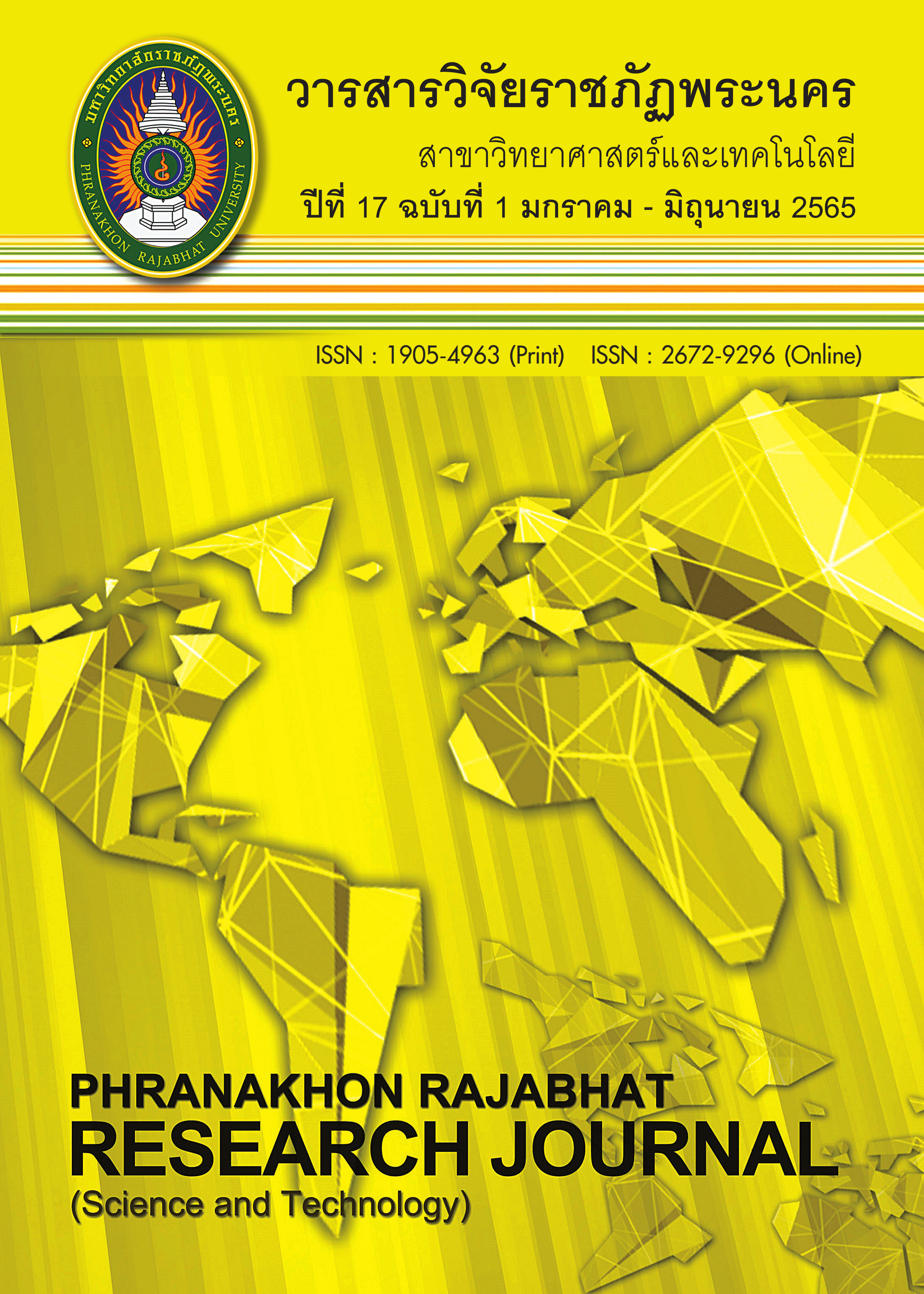การบำบัดสารอินทรีย์ระเหยง่ายในไอระเหยของตัวทำละลายสีพ่นรถยนต์ด้วยเครื่องกรองชีวภาพ
คำสำคัญ:
การบำบัดไอระเหย , สารอินทรีย์ระเหยง่าย, ตัวทำละลาย, เครื่องกรองชีวภาพบทคัดย่อ
งานวิจัยนี้มีวัตถุประสงค์เพื่อศึกษาประสิทธิภาพของเครื่องกรองชีวภาพในการบำบัดสารอินทรีย์ระเหยง่ายในไอระเหยของตัวทำละลายสีพ่นรถยนต์ อัตราส่วนของตัวกลางที่มีผลต่อประสิทธิภาพในการบำบัด และชนิดของจุลินทรีย์ที่เกิดขึ้นในกระบวนการบำบัด การทดลองประกอบด้วยตัวกลางผสมปุ๋ยคอก ดินผสมใบก้ามปู ซังข้าวโพด และตะกอนน้ำเสีย วิเคราะห์สมบัติทางกายภาพและทางเคมี นำตัวกลางมาผสมกันในอัตราส่วน 2: 1: 3: 1, 2: 2: 2: 1 และ 2: 3: 1: 1 โดยปริมาตร ตามลำดับ ตัวแปรควบคุมใช้ความเข้มข้นไอระเหยตัวทำละลายเท่ากับ 400 ppm ในการทดลองนี้กำหนดระยะเวลากักพัก 60 120 และ 180 วินาที ผลการบำบัดสารอินทรีย์ระเหยง่ายในไอระเหยของตัวทำละลายสีพ่นรถยนต์ อัตราส่วนตัวกลางเท่ากับ 2: 3: 1: 1 ผ่านตัวกรองชั้นแรกประสิทธิภาพการบำบัดสูงสุด 90.9 ± 2.0% ผ่านตัวกรองชั้นที่ 2 ประสิทธิภาพการบำบัดสูงสุด 93.5 ± 1.2% และเมื่อผ่านตัวกรองชั้นที่ 3 ประสิทธิภาพการบำบัดสูงสุด 96.4 ± 0.3% ตามลำดับ รองลงมาเป็นอัตราส่วนตัวกลางเท่ากับ 2: 2: 2: 1 ผ่านตัวกรองชั้นแรกประสิทธิภาพการบำบัดสูงสุด 79.7 ± 0.3% ผ่านตัวกรองชั้นที่ 2 ประสิทธิภาพการบำบัดสูงสุด 85.2 ± 0.4% และผ่านตัวกรองชั้นที่ 3 ประสิทธิภาพการบำบัดสูงสุด 90.2 ± 0.2% ตามลำดับ ทั้งนี้จุลินทรีย์เด่นในตัวกลางได้แก่ Bacillus cereus และ Candida tropicalis
เอกสารอ้างอิง
Disaster Prevention and Management Research and Development Center. (2008). Volatile Organic Compounds. Retrieved from http://www.dpm.nida.ac.th/main/index.php/articles/chemical- hazards/item/92 [2021, 19 Mar.]
Erika, P., Rasa, V., Dagnija, B., & Kaspars, I. (2017). Experimental study of droplet biofilter packed with green sphagnum to clean air from volatile organic compounds. Energy Procedia, 128, 373-378.
Gabriel, M. A., & Paulo, E. C. (2016). Customized Computer Vision and Sensor System for Colony Recognition and Live Bacteria Counting in Agriculture. Sensors and Transducers. 201(6), 65-77.
Gurjar, B. R., Butler, T., Lawrence, M. G., & Lelieveld, J. (2008). Evaluation of emissions and air
quality in megacities. Journal of Atmospheric Environment, 42(7), 1593-1606.
Kanpayan, J. (2005). Removal of acetone vapor by biofiltration. (Degree). Chulalongkorn University. Bangkok Thailand.
Office of Air and Sound Quality Management, Pollution Control Department. (2008). Air and noise pollution issues management and management in 2008. Retrieved from http://air4thai.pcd.go.th/webV2/download.php?grpIndex=1 [2021, 25 Oct.]
Office of Environmental Health and Safety. (2012). Exposure Limits and Odor Thresholds. Boston: Massachusetts.
Pollution Control Department. (2021). Thailand's Air and Noise Pollution Situation and Management in 2020. Retrieved from http://www.pcd.go.th/public/Publications/print_report.cfm [2021, 20 Oct.]
Wongphan, L., Panwadee, S., Netnapa, Ch., & Paphana, Kh. (2018). Organic Solvent Vapor Treatment with Bio filter. Journal of Applied Sciences, 17(1), 51-63. (In Thai)
ดาวน์โหลด
เผยแพร่แล้ว
ฉบับ
ประเภทบทความ
สัญญาอนุญาต

อนุญาตภายใต้เงื่อนไข Creative Commons Attribution-NonCommercial-NoDerivatives 4.0 International License.
โปรดกรอกเอกสารและลงนาม "หนังสือรับรองให้ตีพิมพ์บทความในวารสารวิจัยมหาวิทยาลัยราชภัฏพระนคร สาขาวิทยาศาสตร์และเทคโนโลยี" ก่อนการตีพิมพ์




